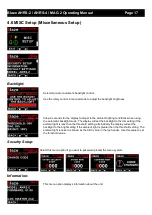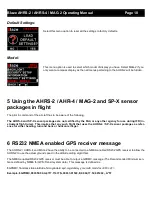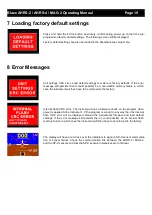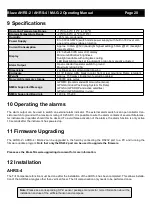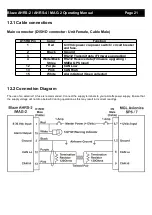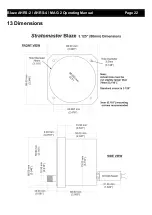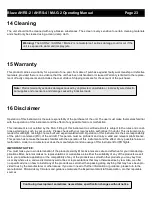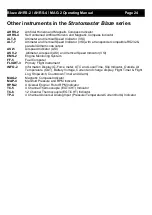
Blaze AHRS-2 / AHRS-4 / MAG-2 Operating Manual
Page 11
To a large extent the AHRS can estimate accelerations acting on your aircraft as it knows the aircraft's velocity. This
means it can estimate a reasonably valid attitude from the accelerometers that is “noisy” even in accelerated flight. For
this to be possible it has to assume how your aircraft moves through space. So it is mostly correct but sometimes not.
The coupling coefficient allows you to trade between the two.
Usually a panel mounted AHRS is affected by vibrations from engines (gyros don't like vibrations). This is the largest error
source for a typical AHRS. If your installation suffers from that a higher coupling number may assist as gyro errors are
larger than normal.
If this does not help you will have to either try and reduce vibrations affecting the panel or install an external AHRS like
the SP-7 or high grade SP-9. This allows locating the AHRS in a more suitable and protected area. If the AHRS-4 detects
an external AHRS it will automatically use it. External AHRS is connected onto the CAN bus.
Tilt Compensate (AHRS-4 only):
This allows installation of the AHRS-4 at angles other than vertical (face). Select this menu item once installation of the
AHRS-4 indicator is complete. The tilt compensation only needs to be performed once. This allows to set a pitch tilt of the
AHRS, keeping all speed related items affecting the accelerometers aligned correctly.
Level Calibrate (AHRS-4 only):
This function can be used to level the AHRS. It levels bank and pitch and sets the Z axis (up down) to 1G.
The level calibrate function here MUST be performed with the AHRS perfectly level, i.e. display in normal orientation at 90
degrees from the horizontal in both pitch and bank. This function “tweaks” the accelerometer sensor using the Earths
gravity as a reference.
This function takes around 10 seconds to execute. Keep the AHRS perfectly still until completed.
Note: The AHRS will refuse to perform this operation if real AHRS bank or pitch angle is greater than 10 degrees.
Reset Gyro Bias (AHRS-4 only):
Your AHRS gyros bias point is the point where your gyros report that you are not rotating around any axis. Gyro bias may
drift over time as the gyro chip ages. This function resets the bias to the current reading and is performed with the aircraft
on the ground, preferably in a hangar with no wind rocking the aircraft. The aircraft may be in any attitude but must remain
perfectly still during this procedure. After you activate this procedure it takes about 30 seconds to complete it. Keep the
aircraft perfectly still during this operation.
CAN TX AHRS (AHRS-4 only):
Select “ON” to output the MGL Avionics SP-7 CAN bus messages. This gives the AHRS-4 the ability to emulate the MGL
Avionics SP-7 sensor package.

















